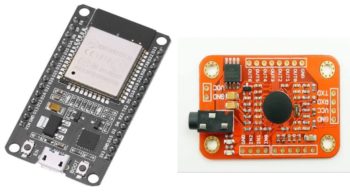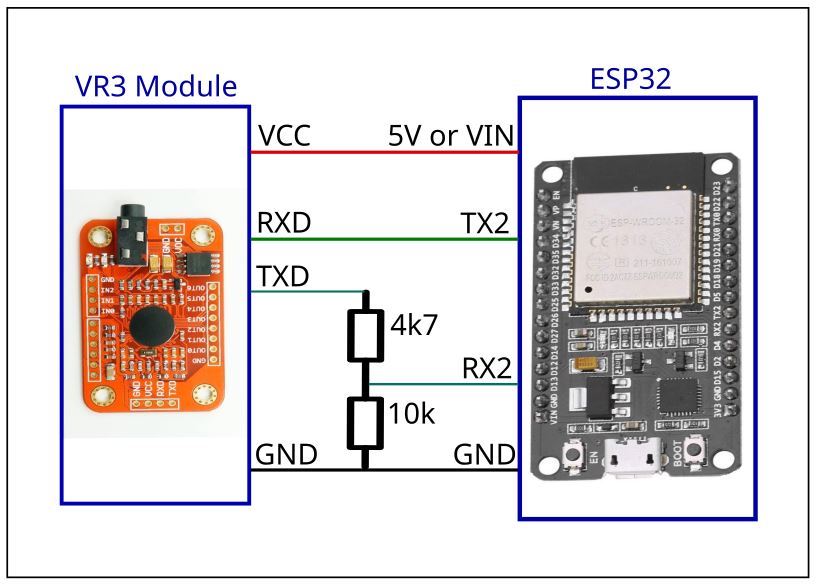
As part of a recent project to add standalone voice control to an oscilloscope, I wanted to marry an Elechouse voice recognition module V3 to an ESP32. Which worked out quite well, hence I’m making both the hardware information and the software available here.
Hardware
A couple of considerations when wiring the two modules together:
- The Elechouse VR3 is a 5V module, and the pins on the ESP32 are not 5V tolerant. Hence the 5V UART output pin from the VR3 needs to be reduced down to 3.3V for the ESP32 input pin. This is easily accomplished using two resistors.
- The ESP32 has 3 serial ports. By default the first, U0UXD, is used for the USB serial port, including for programming. The second, U1UXD, is commonly used to connect to an SPI flash chip. Hence only the third UART, U2UXD, is really safe to use. For this reason, both the wiring diagram shown below, and the software, assume the Elechouse VR3 is attached to the third UART, U2UXD.
Here’s how to wire the modules together:
 ESP32 – Elechouse VR3 Wiring
ESP32 – Elechouse VR3 Wiring
The ESP32 module gets power from its USB port, and provides that to the Elechouse VR3. Depending upon the exact ESP32 board you use, the 5V output pin on the ESP32 board might be named 5V, or it might be named (somewhat confusingly) VIN.
Software
The software uses Arduino running on the ESP32. Here’s a simple tutorial on setting it up:
https://randomnerdtutorials.com/installing-the-esp32-board-in-arduino-ide-windows-instructions/
The board I have selected is “ESP32 Dev Module”.
Make certain you can follow the little tutorial, to build / program / run the example. If you’re having trouble programming the board, try pressing the “boot” button for a few seconds during the programming phase.
Now install the Voice Recognition V3 library. Follow the instructions from the Elechouse github page here:
GitHub – elechouse/VoiceRecognitionV3: Arduino library for elechouse Voice Recognition V3 module
Which is basically just downloading the .zip file and unzipping it into the specified location. BUT, Elechouse provides an older arduino library which does not fully work on the ESP32. Once you’ve installed the Elechouse library, overwrite 4 of those files with my updated files from here:
![]() Or if you prefer, you can grab them individually from github here.
Or if you prefer, you can grab them individually from github here.
These are ESP32-specific files; they won’t work on an Atmel / Microchip Arduino. But they do work for ESP32 Arduino. The files are:
- VoiceRecognitionV3.cpp and .h
- vr_sample_train.ino
- vr_sample_bridge.ino
VoiceRecognitionV3.cpp and .h are the main library file. These have been modified to work on the ESP32 by updating the serial port calls to use the native ESP32 serial port functions. In addition the serial port has been hard-coded (in the “begin” method) to use port U2UXD. When instantiating the class you can pass in other pin numbers but they’re ignored – those parameters are retained for backwards compatibility, but are otherwise ignored.
Transmissions from the ESP32 to the VR3 have also been slowed a little. A small delay has been inserted between successive bytes when sending commands to the VR3 – this appears to improve reliability.
The VR3 defaults to 9600 baud, so when calling the “begin” method, always pass in 9600 unless the VR3 baud rate has been explicitly changed.
vr_sample_train.ino and vr_sample_bridge.ino are two of the examples provided by Elechouse, and they’re very useful. The only change made to these two files is deleting this line:
#include <SoftwareSerial.h>
from each of them. As SoftwareSerial is not applicable to ESP32 Arduino, and results in a build error.
For how & why to use vr_sample_train and vr_sample_bridge, see the Elechouse documentation
https://www.elechouse.com/elechouse/images/product/VR3/VR3_manual.pdf
or my oscilloscope voice control project, where I describe how to train and use the VR3 module.
Summary
That’s all there is to it. Some simple wiring including a couple of resistors. Arduino on the ESP32 with the updated ESP32 Elechouse Voice Recognition V3 software files. Then you’re free to train the VR3 with your words, and have the ESP32 do things when those words are spoken. For the oscilloscope voice control it’s working quite nicely.
